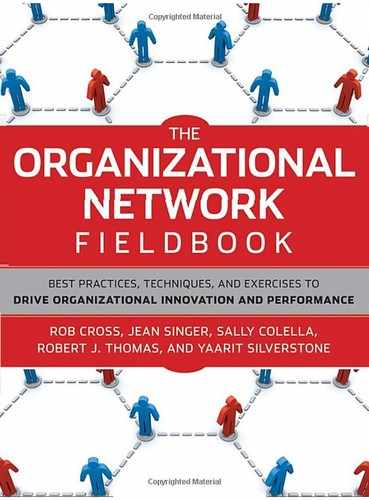23.2. Launching the Mentoring Program
The fundamental idea behind Smart Mentoring was to create mentoring relationships between central and peripheral players in the Knowledge Lab network. Central people would be able to offer connections and better integrate their peripheral mentees into the flow of organizational knowledge. The peripheral people would bring unnoticed or undervalued skills and perspectives more clearly into the organization's problem-solving discussions. Everyone would benefit from a greater degree of knowledge-sharing overall.
23.2.1. Enlisting Mentors and Mentees
We chose the people to participate in the Smart Mentoring program on the basis of the ONA findings. To form the mentoring pairs, we identified 22 very central individuals as potential mentors and 33 less connected individuals as potential mentees. The potential mentors were not only central to the network but also were brokers, people who have relationships across various subgroups. Because they serve as a bridge between individuals who do not otherwise know one another, brokers can be tremendously influential in a network, helping to disseminate new ideas and ways of working. Our goal in pairing brokers with peripheral people was to quickly boost the network's overall connectivity.
We then contacted the potential mentors individually, informing them that they had been identified as individuals in key positions in the network and asking them to become involved in a Knowledge Lab program to help others become more collaborative. These potential mentors, flattered to have been invited to play an important role in the organization's development, generally responded positively.
Inviting mentees—people who were on the periphery of the network—to participate was a more delicate task. These were largely new and young employees, who would not necessarily appreciate being told that others in the DIA thought they needed help. We decided that the best way to approach them was through a short narrative. So the Lab members created a marketing pitch that focused on the opportunity to meet experienced, seasoned employees who felt the same way as the newcomers did about the need for change. Potential mentees were asked, "How would you like to be better connected to people in DIA who themselves are well connected and share your belief that the DIA needs to become more agile and creative, and less risk averse?" Potential mentees responded positively to this approach, which came with an implicit promise of self-development in a safe environment.
23.2.2. Gaining General Acceptance
Another challenge was to gain acceptance for the new program in an organization that already had a traditional mentoring program. Because our initiative was not part of the official DOD program, we had to frame it as an experiment that had objectives beyond individual development. We met with the members of the official mentoring program, explained the project, and reached an understanding on how to gain value from two programs with two different sets of objectives.
23.2.3. Roles of Mentors and Mentees
To launch the Smart Mentoring program, each mentor crafted an autobiography and supplied a photograph. We emailed the autobiographies to the mentee candidates, who were asked to rank the top three mentors with whom they would like to be paired. An independent consultant supported a process to match the pairs, based on this initial show of interest and other network factors. To help the program succeed, we also made sure that all participants obtained permission from their supervisors and that they would actually take the time to participate fully in the program and were not about to take on a new work assignment or go on an extended business trip.
The final number of pairs participating in Smart Mentoring was 12. After the pairings were completed, we e-mailed the mentor and mentee about the pairing and goals of the program. The mentor and mentee then worked together to create specific objectives for their relationship.
23.2.3.1. Mentors
The mentors were asked to help mentees increase their knowledge and experiences. Mentors would help mentees do the following:
Achieve a diverse network.
Add new people to their network.
Develop strong relationships with a few well-connected colleagues.
Gain access to a broad base of knowledge.
Engage in activities that would keep them on the cutting edge.
Be proactive and intentional in developing relationships.
Spend time getting work done (instead of engaging in political or self-marketing activities) to achieve a good reputation and attract new opportunities.
23.2.3.2. Mentees
Mentees were asked to help mentors understand a new generation of employees, in particular regarding matters of communication and technology. Mentees would do the following:
Identify the most crucial bottlenecks and barriers that new employees face, including communication and process barriers.
Help break down the communication barriers that sometimes exist between newer and more tenured employees.
Help the organization understand what new employees want and need.
Become a bridge between newer and more experienced employees.
Incorporate new energy and skills sets, such as technology skills, into their work.
23.2.3.3. Providing Examples
To help mentors and mentees begin immediately to form useful and trusting relationships, we provided each pair with examples of what to look for during their initial conversations. For instance, mentors were urged to develop an understanding of the ways their mentees communicated orally and through technology. Mentees were urged to become more aware of their mentors' connections and the various ways they moved ideas and questions through the organization.
